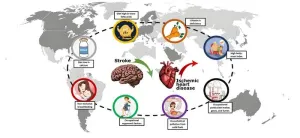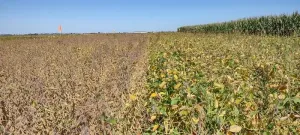(Press-News.org) People with chronic liver disease can be categorized into four distinct risk groups based on the different barriers they face in obtaining outpatient care, barriers that increase their odds of requiring hospitalization, a new UCLA study finds.
The findings, to be published November 20 in the peer-reviewed PLOS ONE, point to the need for interventions aimed at reducing possibly avoidable hospitalizations among the highest-risk people with chronic liver disease (CLD). Previous research has found that people with CLD on average need more hospital-based care than those with other chronic diseases.
About 4 million adults in the US have CLD, said Dr. Carrie Wong, assistant professor of medicine in the division of digestive diseases at the David Geffen School of Medicine at UCLA and the study’s lead author.
“We need to address community-based health care barriers, particularly for persons who struggle to establish care, as a potential approach to reduce recurrent hospital use among adults with chronic liver disease in the US,” Wong said.
The researchers used National Health Interview Survey data from 2011 to 2017 to tease out a nationally representative sample of people that self-reported their encounters with barriers in the survey. The timeframe was chosen to capture respondents’ health care experiences after the Affordable Care Act was enacted. They evaluated the risk groups by sociodemographic, health and insurance characteristics to identify salient features of people in each group and to measure their likelihood of needing recurrent care.
Overall the experiences of just over 5000 people were included in the sample which represented about 4.7 million US adults with CLD. They were asked 13 questions such as whether a doctor’s office or clinic did not accept them as a new patient, if they were unable to afford a specialist or obtain prescription medications, or had to delay care due to a lack of transportation.
Based on the results, the researchers categorized people with CLD into four unique risk groups based on the types of barriers they faced: “minimal barriers,” a group comprising 78.1% of the sample and were older, had the lowest proportion with fair or poor health, and fewer economic and social limitations; “health care unaffordability” (10.7%); “care delays” (6.5%), and “inability to establish care” (4.8%).
The unaffordability group had the most uninsured people, those in the care delay group were mostly insured, and people who were unable to establish care included the most adults under age 65, females, the unemployed, or lived in poverty.
Compared with those with minimal barriers to care, people who were unable to establish care were 85% more likely to need recurrent hospital-based care. In addition, females as well as people with health-related physical limitations were particularly unable to establish care.
The researchers note that the study is a pooled-cross sectional look from which causal inferences cannot be drawn. Other limitations include the researchers’ inability to capture the respondents’ severity of CLD and lack of details about health insurance plans and more recent experiences with health care barriers.
However, “our results can be leveraged in future prioritization efforts that aim to reduce avoidable recurrent acute care among the most vulnerable persons with CLD, particularly those who frequently face organizational barriers at entry to health care,” the researchers write.
Study co-authors are Catherine Crespi, Beth Glenn, Dr. Steven Han, James Macinko, and Roshan Bastani of UCLA.
END
Over 4 million US adults with chronic liver disease can be grouped into unique risk groups based on barriers to care
Liver patients already need more hospital-based care than people with other chronic diseases
2024-11-20
ELSE PRESS RELEASES FROM THIS DATE:
Robot flies like a bird
2024-11-20
Have you ever wondered why an airplane has a vertical tailfin? The plane needs it to stabilize its flight. Since flying without a vertical tail is much more energy-efficient, the aviation industry has worked hard to accomplish this – so far without much success. However, birds don’t need a vertical fin, which raises the question: how do they do it?
David Lentink, Professor of Biomimetics at the University of Groningen, has developed a robotic bird model with real pigeon feathers to show how they do it. In previous work, he found that birds continuously ...
Won’t you be mine? Neighborly networking may motivate local climate action
2024-11-20
Individual motivation to act against climate change outweighs the impact of hyperlocal collective intentions, though both approaches are worth strengthening, according to a survey of nine European neighborhoods published Nov. 20, 2024 in the open-access journal PLOS Climate by Christian A. Klöckner from the Norwegian University of Science and Technology and colleagues.
Western society contests the individual versus collective responsibility to combat climate change. But do people feel more motivated to act individually (e.g., making waste-free purchasing choices) or in tandem with others (e.g., protesting or completing ...
Mental health issues are "prevalent and troubling" among forcibly displaced children and young people, per scoping review which finds PTSD, anxiety and depression to be most common conditions
2024-11-20
Mental health issues are "prevalent and troubling" among forcibly displaced children and young people, per scoping review which finds PTSD, anxiety and depression to be most common conditions.
+++++
Article URL: https://journals.plos.org/mentalhealth/article?id=10.1371/journal.pmen.0000076
Article Title: Mental health issues of children and young people displaced by conflict: A scoping review
Author Countries: Nigeria, United States
Funding: The authors received no specific funding for this work. END ...
How nerve stimulation could ease inflammatory bowel disease
2024-11-20
Researchers at Duke University School of Medicine have found that tapping into the nervous system could help reduce the gut inflammation that drives inflammatory bowel disease (IBD).
A new study led by Luis Ulloa, PhD, and Wei Yang, PhD, reveals how electrical stimulation of the vagus nerve—a major nerve connecting the brain and gut—may combat the stress-related inflammation that worsens IBD symptoms.
Published in Science Translational Medicine, the study showed that vagus nerve stimulation in stressed mice with colitis, a form of IBD, reduced inflammation, improved symptoms, ...
The factors behind the shifting trends of ischemic heart disease and stroke
2024-11-20
Incidence of stroke and ischemic heart disease are declining around the world, except for in a handful of regions, according to research in the open access journal PLOS Global Public Health. Wanghong Xu of Fudan University and colleagues find that in East and West Sub-Saharan Africa, East and Central Asia and Oceania, ischemic heart disease is increasing, which may be attributed to eight factors that include diet, high BMI, household air pollution and more.
Cardiovascular disease is a leading cause of death and disability worldwide, and ischemic heart disease and stroke ...
How educational attainment may impact memory and dementia risk later in life
2024-11-20
Historical policies shaping educational attainment have enduring benefits for later life memory and risk of dementia, according to a study led by a Rutgers Health researcher.
The study, published in Epidemiology, compared the differences in years of education based on variations in state schooling mandates with cognitive performance outcomes in residents decades later.
“Policies to increase the quantity or quality of schooling now are likely to have long-term benefits on cognitive outcomes,” ...
Growing soybeans has a surprisingly significant emissions footprint, but it’s ripe for reduction
2024-11-20
AMES, Iowa – Over the typical two-year rotation of corn and soybeans most Iowa farmers use, 40% of nitrous oxide emissions are in the soybean year, according to a new study by an Iowa State University research team.
The share of the potent greenhouse gas released during the soybean half of a crop rotation cycle is surprisingly high, given most soybeans fields aren’t treated with nitrogen, said Michael Castellano, agronomy professor and William T. Frankenberger Professor of Soil Science at Iowa State University.
“We’ve just been assuming that legume crops like soybeans don’t have a big emissions footprint because they don’t ...
$6 million grant drives potential treatment for common cause of vision loss toward the clinic
2024-11-20
The California Institute for Regenerative Medicine (CIRM), the state’s stem cell agency, has awarded a two-year, $6 million grant to a team at the USC Dr. Allen and Charlotte Ginsburg Institute for Biomedical Therapeutics and the USC Roski Eye Institute advancing a new treatment for one of the leading causes of blindness in older adults. The funding will enable the researchers to conduct preclinical studies needed before launching human trials.
The investigators aim to accelerate progress in fighting dry age-related macular degeneration (AMD), which affects ...
Research aims to roll back contamination caused by toxic tires
2024-11-20
University of Delaware researchers have developed a method for mitigating the decontamination that tires release into the environment at the end of their lifespan.
In a new study published in Nature Chemical Engineering, the team demonstrated a way to upgrade 6PPD – a molecule that provides UV protection to help the rubber found in tires last longer – into safe chemicals. The method would also turn the leftover crumb rubber into aromatics and carbon black, a soot-like material found in everything from pigments to cosmetics to electronics. ...
School social workers an underutilized resource
2024-11-20
Youth in America are experiencing a mental health crisis, according to the Centers for Disease Control and Prevention (CDC). The CDC reports that an increasing number of students are experiencing symptoms of hopelessness, depression, and anxiety, along with thoughts of self-harm.
One thing known to improve mental health among students is increased school connectedness—when students feel that the adults and peers in their school care about them as individuals in addition to their learning ability. Schools are working to improve their connectedness by adding social workers to their staff to help address the mental health concerns of students.
However, ...
LAST 30 PRESS RELEASES:
Numbers in our sights affect how we perceive space
SIMJ announces global collaborative book project in commemoration of its 75th anniversary
Air pollution exposure and birth weight
Obstructive sleep apnea risk and mental health conditions among older adults
How talking slows eye movements behind the wheel
The Ceramic Society of Japan’s Oxoate Ceramics Research Association launches new international book project
Heart-brain connection: international study reveals the role of the vagus nerve in keeping the heart young
Researchers identify Rb1 as a predictive biomarker for a new therapeutic strategy in some breast cancers
Survey reveals ethical gaps slowing AI adoption in pediatric surgery
Stimulant ADHD medications work differently than thought
AI overestimates how smart people are, according to HSE economists
HSE researchers create genome-wide map of quadruplexes
Scientists boost cell "powerhouses" to burn more calories
Automatic label checking: The missing step in making reliable medical AI
Low daily alcohol intake linked to 50% heightened mouth cancer risk in India
American Meteorological Society announces Rick Spinrad as 2026 President-Elect
Biomass-based carbon capture spotlighted in newly released global climate webinar recording
Illuminating invisible nano pollutants: advanced bioimaging tracks the full journey of emerging nanoscale contaminants in living systems
How does age affect recovery from spinal cord injury?
Novel AI tool offers prognosis for patients with head and neck cancer
Fathers’ microplastic exposure tied to their children’s metabolic problems
Research validates laboratory model for studying high-grade serous ovarian cancer
SIR 2026 delivers transformative breakthroughs in minimally invasive medicine to improve patient care
Stem Cell Reports most downloaded papers of 2025 highlight the breadth and impact of stem cell research
Oxford-led study estimates NHS spends around 3% of its primary and secondary care budget on the health impacts of heat and cold in England
A researcher’s long quest leads to a smart composite breakthrough
Urban wild bees act as “microbial sensors” of city health.
New study finds where you live affects recovery after a hip fracture
Forecasting the impact of fully automated vehicle adoption on US road traffic injuries
Alcohol-related hospitalizations from 2016 to 2022
[Press-News.org] Over 4 million US adults with chronic liver disease can be grouped into unique risk groups based on barriers to careLiver patients already need more hospital-based care than people with other chronic diseases




